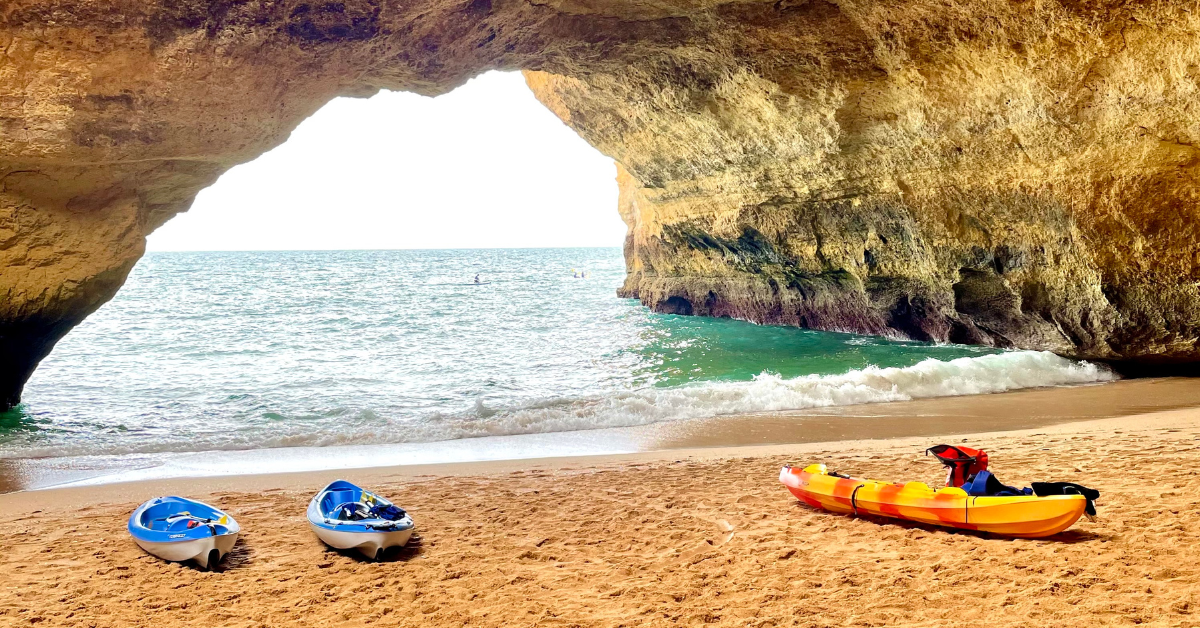Sea Cave Kayaking 101: Your Complete Guide to Phang Nga Bay Adventures

Imagine lying flat in your kayak, paddle held close to your chest, as your guide gently pushes you through a narrow opening in a towering limestone cliff. For a moment, you’re in complete darkness, water lapping softly around you. Then suddenly, you emerge into a hidden lagoon surrounded by 80-meter walls, where emerald water reflects ancient limestone formations and the only sounds are your own breathing and the distant calls of exotic birds.
Welcome to sea cave kayaking in Phang Nga Bay—one of the world’s most extraordinary adventure experiences. For over three decades, Andaman Sea Kayak has been pioneering safe exploration of Thailand’s most spectacular limestone cave systems, turning what was once the domain of expert cavers into accessible adventures for travelers seeking authentic encounters with nature’s hidden masterpieces.
This complete guide will prepare you for everything you need to know about sea cave kayaking in Phang Nga Bay, from understanding the basics to making the most of your adventure in one of Earth’s most dramatic landscapes.

Understanding Sea Cave Kayaking
What Makes Phang Nga Bay Special?
Phang Nga Bay represents one of the world’s premier sea cave kayaking destinations due to its unique geological features and accessible cave systems.
Geological Advantages:
- Limestone karst formations: Over 100 towers with extensive cave systems
- Tidal accessibility: Many caves are accessible only by kayak during specific tides
- Hidden lagoons: Enclosed chambers (called “hongs”) accessible only through caves
- Diverse cave types: From simple swim-throughs to complex multi-chamber systems
- Stable formations: Ancient limestone provides safe, well-formed cave passages
Perfect Conditions:
- Warm water year-round: 26-30°C (79-86°F) temperature
- Predictable tides: Reliable patterns allow precise timing for cave access
- Calm protected waters: Limestone formations create natural windbreaks
- Excellent visibility: Clear water allows safe navigation
- Tropical climate: Comfortable conditions for water activities
Types of Sea Caves in Phang Nga Bay
Not all caves are created equal. Understanding different cave types helps set appropriate expectations and excitement levels.
Simple Swim-Through Caves:
- Characteristics: Short passages with visible exits
- Difficulty: Beginner-friendly
- Duration: 30 seconds to 2 minutes passage time
- Features: Single passage connecting two water bodies
- Examples: Many caves around James Bond Island area
Hong Lagoon Caves:
- Characteristics: Lead to enclosed lagoons within limestone formations
- Difficulty: Intermediate (requires tidal timing)
- Duration: 5-15 minutes in cave, extended time in lagoon
- Features: Hidden chambers accessible only through narrow cave entrances
- Examples: Koh Hong Island complex, various hidden lagoons
Complex Cave Systems:
- Characteristics: Multiple chambers, branching passages, advanced navigation
- Difficulty: Advanced (expert guides essential)
- Duration: 15-45 minutes exploring interconnected chambers
- Features: Stalactites, ancient formations, archaeological sites
- Examples: Specialist caves known only to experienced guides
Safety First: Understanding Cave Kayaking Risks
Why Professional Guides Are Essential
Sea cave kayaking in Phang Nga Bay requires expert knowledge that takes years to develop safely.
Guide Expertise Requirements:
- Tidal knowledge: Understanding precise timing for safe cave access
- Navigation skills: Ability to navigate complex systems in darkness
- Emergency procedures: Training in cave rescue and emergency evacuation
- Weather assessment: Reading conditions that affect cave safety
- Equipment expertise: Ensuring proper gear for cave conditions
Specific Hazards:
- Tidal trapping: Getting caught in caves when tides change
- Low visibility: Navigating in complete darkness
- Narrow passages: Potential for getting stuck or panicking
- Falling rocks: Limestone erosion creates occasional rockfall risks
- Weather changes: Sudden conditions affecting cave accessibility
Andaman Sea Kayak’s guides undergo extensive training and have decades of experience navigating these specific challenges.
Essential Safety Equipment
Professional sea cave kayaking requires specialized equipment beyond basic kayaking gear.
Safety Equipment Provided:
- Professional-grade kayaks: Stable, maneuverable boats designed for cave conditions
- High-quality life jackets: Properly fitted flotation appropriate for cave environments
- Headlamps: Waterproof lighting with backup power sources
- Emergency whistles: Communication devices for low-visibility conditions
- First aid equipment: Comprehensive medical supplies for remote locations
- Emergency communication: Radios for contact with support vessels
Personal Items to Bring:
- Reef-safe sunscreen: Protection that won’t harm marine ecosystems
- Water shoes: Grip and protection for rocky surfaces
- Quick-dry clothing: Comfort during and after water activities
- Waterproof bags: Protection for cameras, phones, and personal items

What to Expect: Your Cave Kayaking Adventure
Pre-Adventure Briefing
Every Andaman Sea Kayak cave adventure begins with comprehensive preparation.
Safety Briefing Components:
- Paddle technique: Efficient strokes for cave navigation
- Cave entry procedures: How to navigate narrow passages safely
- Communication signals: Hand signals and verbal cues for low-light conditions
- Emergency procedures: What to do if separated or in distress
- Environmental guidelines: Protecting cave formations and marine life
Equipment Familiarization:
- Kayak stability: Understanding your boat’s handling characteristics
- Paddle coordination: Practicing efficient movement
- Life jacket adjustment: Ensuring proper fit and comfort
- Headlamp operation: Testing lighting equipment
- Dry bag sealing: Protecting personal items from water
The Cave Entry Experience
Your first cave entry is often the most memorable moment of the entire adventure.
Typical Entry Sequence:
- Approach: Guide assesses conditions and explains specific entry technique
- Positioning: Arranging kayaks in proper order for safe passage
- Entry preparation: Adjusting position, securing equipment, activating lights
- Guided passage: Following guide’s instructions through narrow opening
- Emergence: Entering the hidden world beyond the cave
Sensory Experience:
- Visual: Transition from bright sunlight to darkness to filtered cave light
- Auditory: Outside noise fades, replaced by water echoes and your own breathing
- Temperature: Cool cave air contrasts with warm tropical sunshine
- Spatial: Intimate cave passages opening into vast hidden chambers
- Emotional: Excitement, wonder, and connection with ancient geological processes
Inside the Caves
The experience inside Phang Nga Bay’s sea caves varies dramatically depending on the specific system you’re exploring.
Common Cave Features:
- Stalactites: Ancient limestone formations hanging from cave ceilings
- Flowstone: Smooth limestone created by thousands of years of water flow
- Cave pearls: Small spherical formations created by water circulation
- Fossil inclusions: Ancient marine life preserved in limestone walls
- Natural windows: Openings that create dramatic lighting effects
Wildlife Encounters:
- Bats: Various species roosting in upper cave reaches
- Cave fish: Specialized species adapted to low-light environments
- Crustaceans: Crabs and shrimp living in cave pools
- Birds: Swiftlets and other species nesting in cave systems
- Marine life: Fish and invertebrates in cave entrances and passages
Hidden Hong Lagoons: The Ultimate Reward
What Are Hong Lagoons?
The term “hong” means “room” in Thai, perfectly describing these enclosed lagoons hidden within limestone formations.
Hong Characteristics:
- Complete enclosure: Surrounded on all sides by towering limestone walls
- Single access: Reachable only through narrow cave passages
- Tidal dependence: Accessible only during specific tide conditions
- Pristine ecosystems: Undisturbed environments with unique marine life
- Acoustic qualities: Natural amphitheaters with extraordinary sound properties
Famous Hong Lagoons:
- Koh Hong Island: The largest and most spectacular hong in Phang Nga Bay
- James Bond Island Secret Hong: Hidden lagoon behind the famous rock formation
- Koh Panak Hong: Multiple smaller lagoons connected by cave systems
- Secret locations: Known only to experienced guides with decades of exploration
The Hong Experience
Entering a hidden hong lagoon represents the pinnacle of sea cave kayaking adventure.
Typical Hong Visit:
- Cave approach: Navigating through narrow limestone passages
- Emergence: Sudden opening into vast enclosed space
- Exploration: Paddling around lagoon perimeter, observing walls and wildlife
- Contemplation: Quiet time to appreciate the extraordinary environment
- Photography: Capturing the drama of limestone walls and reflected light
Why Hongs Are Special:
- Exclusivity: Only accessible by kayak, limiting visitor numbers
- Pristine condition: Protected from development and mass tourism
- Unique ecosystems: Isolated environments supporting rare species
- Geological wonder: Direct experience of millions of years of limestone formation
- Spiritual quality: Natural cathedrals that inspire awe and reflection
Planning Your Cave Kayaking Adventure
Choosing the Right Tour
Different tour options cater to various experience levels and interests.
Beginner Tours:
- Duration: Half-day (4-5 hours)
- Cave complexity: Simple swim-throughs and easy hong access
- Group size: Up to 10 people for personalized attention
- Physical requirements: Basic swimming ability and moderate fitness
- Best for: First-time kayakers, families with children, those wanting overview experience
Intermediate Adventures:
- Duration: Full day (6-8 hours)
- Cave complexity: Multiple hong lagoons, moderate cave systems
- Group size: 6-8 people for more intimate experience
- Physical requirements: Good swimming ability, comfortable with confined spaces
- Best for: Active travelers seeking comprehensive cave exploration
Advanced Expeditions:
- Duration: Multi-day or extended single-day adventures
- Cave complexity: Challenging cave systems, remote locations
- Group size: 4-6 people maximum
- Physical requirements: Strong swimming, cave experience helpful
- Best for: Adventure enthusiasts seeking ultimate cave experiences
Best Times for Cave Kayaking
Timing significantly affects the quality and safety of your cave kayaking experience.
Seasonal Considerations:
- High season (November-March): Best weather, calm conditions, optimal visibility
- Shoulder season (April-May, October): Good conditions, fewer crowds
- Monsoon season (June-September): Limited cave access, weather-dependent
Daily Timing:
- Morning tours: Cooler temperatures, often calmer conditions
- Afternoon tours: Dramatic lighting, fewer tour groups
- Tide dependence: Some caves accessible only during specific tidal windows
Weather Factors:
- Wind conditions: Affect accessibility of outer caves
- Rain: Can reduce visibility and create challenging conditions
- Swell patterns: Influence safety in cave entrances
Physical Preparation
While sea cave kayaking doesn’t require extreme fitness, basic preparation enhances enjoyment and safety.
Physical Requirements:
- Swimming ability: Essential for safety in water environments
- Basic fitness: Ability to paddle moderately for several hours
- Flexibility: Comfort getting in and out of kayaks
- Balance: Basic stability for kayak maneuvering
- Claustrophobia considerations: Comfort in confined cave spaces
Preparation Suggestions:
- Cardiovascular fitness: Walking, swimming, or cycling for endurance
- Core strength: Exercises to support efficient paddling
- Flexibility work: Stretching for comfort during long sitting periods
- Water comfort: Pool or open water practice if you’re nervous about water activities
What to Bring and What to Leave Behind
Essential Items
Personal Gear:
- Swimwear: Quick-dry materials that are comfortable when wet
- Sun protection: Hat, sunglasses, reef-safe sunscreen
- Water shoes: Protection and grip on rocky surfaces
- Waterproof bag: For phones, cameras, and valuables
- Change of clothes: Dry clothing for after the adventure
Optional Items:
- Underwater camera: Waterproof photography equipment
- Snorkeling gear: Mask and fins for underwater exploration
- Personal water bottle: Stay hydrated during the adventure
- Light snacks: Energy food for longer adventures
What to Leave Behind
Items to Avoid:
- Jewelry: Risk of loss in water
- Cotton clothing: Takes too long to dry
- Excessive electronics: Minimize risk of water damage
- Rigid expectations: Nature determines cave accessibility
- Fear of getting wet: You will definitely get wet!

Understanding Tides and Cave Access
Why Tides Matter
Tidal timing is crucial for safe and successful cave kayaking in Phang Nga Bay.
Tidal Effects:
- Cave accessibility: Many caves are only passable at specific tide levels
- Safety considerations: Wrong tides can trap kayakers or make caves dangerous
- Hong lagoon access: Some lagoons are only reachable during narrow tide windows
- Water clarity: Tidal movement affects visibility in cave systems
Optimal Tide Conditions:
- Mid-tide levels: Usually best for cave access
- Rising or falling tides: Timing entries and exits appropriately
- Spring vs. neap tides: Different tidal ranges affect cave accessibility
- Local variations: Each cave system has specific optimal conditions
Professional guides time tours precisely to ensure safe access to the most spectacular caves and lagoons.
Environmental Responsibility
Protecting Cave Ecosystems
Sea caves represent fragile ecosystems that require careful protection.
Environmental Guidelines:
- No touching: Cave formations are delicate and easily damaged
- Quiet observation: Minimize noise to avoid disturbing wildlife
- No collection: Leave everything natural in place
- Waste management: Pack out all trash and waste
- Reef-safe products: Use only environmentally friendly sunscreens and products
Why Protection Matters:
- Geological heritage: Cave formations took millions of years to create
- Unique ecosystems: Cave environments support specialized species
- Cultural significance: Many caves hold importance for local communities
- Future access: Damage can result in cave closures
- Global responsibility: These formations exist nowhere else on Earth
Supporting Conservation
Choosing responsible tour operators supports long-term cave conservation.
Conservation Support:
- Local partnerships: Operators working with communities for protection
- Scientific research: Contributing data about cave ecosystems
- Education programs: Learning about conservation during adventures
- Sustainable practices: Minimal impact tourism methods
- Economic incentives: Making conservation economically viable
After Your Cave Adventure
Processing the Experience
Sea cave kayaking often creates lasting impressions that benefit from reflection and integration.
Common Reactions:
- Awe and wonder: Amazement at geological beauty and scale
- Physical satisfaction: Accomplishment from challenging adventure
- Environmental awareness: Increased appreciation for natural preservation
- Cultural connection: Understanding of human relationship with these landscapes
- Personal growth: Overcoming fears or physical challenges
Sharing Responsibly
Sharing your cave kayaking experience can inspire others while protecting sensitive locations.
Responsible Sharing:
- Focus on experience rather than exact locations: Protect secret spots from overuse
- Emphasize safety requirements: Highlight need for professional guides
- Promote conservation: Share messages about environmental protection
- Support responsible operators: Recommend companies with conservation commitments
- Inspire respectful adventure: Encourage others to approach nature respectfully
Advanced Cave Kayaking Opportunities
Multi-Day Cave Expeditions
For experienced adventurers, extended cave kayaking expeditions offer deeper exploration opportunities.
Extended Adventure Features:
- Remote cave systems: Access to locations requiring overnight stays
- Comprehensive exploration: Time for detailed investigation of complex cave networks
- Scientific participation: Opportunities to contribute to cave research
- Cultural immersion: Extended interaction with local communities
- Personal challenge: Ultimate adventure for experienced kayakers
Specialized Interest Tours
Different tours cater to specific interests and expertise levels.
Photography Tours:
- Optimal lighting: Timing for best cave photography conditions
- Equipment support: Assistance with waterproof camera systems
- Composition guidance: Help capturing dramatic cave scenes
- Technical instruction: Cave photography techniques and safety
Geology Tours:
- Expert interpretation: Detailed explanation of cave formation processes
- Fossil identification: Learning to recognize ancient marine life
- Rock formation analysis: Understanding limestone development
- Scientific context: Connection to broader geological processes
Cultural Tours:
- Archaeological sites: Visiting caves with historical significance
- Traditional knowledge: Learning from local cave exploration traditions
- Spiritual practices: Understanding cultural significance of cave systems
- Community connections: Meeting people whose lives connect to cave environments
Conclusion: Your Gateway to Wonder
Sea cave kayaking in Phang Nga Bay offers more than just adventure—it provides direct connection to some of Earth’s most extraordinary natural architecture. These limestone cathedrals, carved by millions of years of patient water work, create spaces that inspire awe, wonder, and deep appreciation for the natural world’s creative power.
Through three decades of safe, respectful cave exploration, Andaman Sea Kayak has demonstrated that these spectacular environments can be shared with visitors while maintaining their pristine condition and protecting their delicate ecosystems. Their expertise ensures that your cave kayaking adventure will be both thrilling and safe, combining excitement with education and personal challenge with environmental awareness.
Whether you’re seeking your first sea cave experience or looking to deepen your connection with these remarkable environments, Phang Nga Bay’s limestone labyrinth offers adventures that will remain with you long after you’ve returned to dry land. The hidden lagoons, ancient formations, and pristine ecosystems represent some of our planet’s most precious natural treasures—places that remind us of the beauty, complexity, and fragility of the natural world.
Your sea cave kayaking adventure awaits in the emerald waters of Phang Nga Bay, where every paddle stroke brings you deeper into one of nature’s most spectacular masterpieces.










